Jesper Norda | selected works .
______________________________________

sound
installations .
Gravitationshändelser (2023)
Katrineholms Konsthall / Katrineholms Gamla Vattentorn
(Video above with swedish subtitles, for english click here.)
Gravity Events (Gravitationshändelser) was installed in the summer of 2023 in Katrineholm's Old Water Tower. The water tower is 49 metres high and was built in 1906-1907 after drawings by architect Ivar Tengbom.
The 4-channel sound installation consists of a pair of large loudspeakers placed at the top of the tower - and two surface transducers placed at floor level. The sound coming from the speakers at the top of the tower is orchestral with an atmospheric timbre, while the sound emanating from the plywood discs is more soloistic - bodily, pregnant. The cables run from the top of the tower, a visual and actual connection between ceiling and floor. The sound moves in waves between these pairs of speakers.
The sound is based on a composition by J.S. Bach: Nun komm der Heiden Heiland.
"If you think of Bach's notation as one long musical system - five lines of notes with a large number of notes placed in a harmonic and rhythmic flow - I have placed along this line a number of 'gravity points' that attract the notes in the score: melodies and bass lines become clusters of notes."
This creates a chordal structure that undulates back and forth, all the chords are connected, but sound slightly different, like waves rolling in on a beach. The music is played by a string orchestra. The noise in the recording - the noise from the microphones, the scratching of the strings against the string - is separated from the sound itself. The noise is allowed to float freely on its own. Body and air. This creates the sound that has a timbre that may sound like waves, or wind.
The exhibition was produced by Katrineholms Konsthall.

Fåglad (version) (2021-2022)
Boy Konsthall (separat), Bollebygd, dec 2021 - jan 2022
Rydals Museum (Ingen Å är en Ö, grupputställning), Marks kommun, maj - okt 2022
Fåglad (Version 2021) uppfördes som separatutställning på Boy Konsthall, Bollebygd samt i grupputställningen Ingen Å är en Ö på Rydals Museum, som en del av det tvärvetenskapliga projektet Skimmer och Härvor i Viskans Vatten och Marker.
Curatorer: Thomas Laurien och Theo Ågren.
Platsen där jag samlat in ljudmaterial till Fåglad (Version 2021) är ett litet område i skogarna kring Bollebygd, mittemellan två små sjöar, Smulingtjärnen och Stora Ringtjärnen. Trots sjöarnas direkta närhet till varandra (de ligger mindre än 100 meter från varandra) tillhör de olika vattensystem. Smulingtjärnen rinner ut i Rolfsån vid Kungsbacka och Stora Ringtjärnen rinner ut i Viskan i Varberg.
Träkonstruktionen rymmer två ljudverk: Korparna och Svartmesen. Korparna består av en ljudupptagning gjord på en punkt exakt mittemellan sjöarna. Om det faller en regndroppe på platsen där mikrofonen är placerad vet vi inte om vattnet som ryms i denna droppe kommer att söka sig österut till Viskans vattensystemeller västerut för att senare nå havet via Rolfsån.
I slutet av den minut som utgör inspelningen behövde jag ta ett steg för att hålla balansen och störde då ett par korpar som satt i närheten. Denna händelse av balans/obalans kan man lyssna till mellan väggarna i träkonstruktionen.
Svartmesar är talrika i området kring sjöarna. En inspelning av en ensam svartmes spelas från de två högtalarna som är placerade på varsin sida träkonstruktionen och fyller rummet. Ljudet är delat i två delar, varannan ljudimpuls kommer från den vänstra högtalaren, varannan från den högra. Ljudet är således helt så länge ingen människa befinner sig i utställningsrummet.
I det ögonblick en människa befinner sig i utställningen skapas en referenspunkt.
Någon varseblir klyvningen - ljudet faller isär.
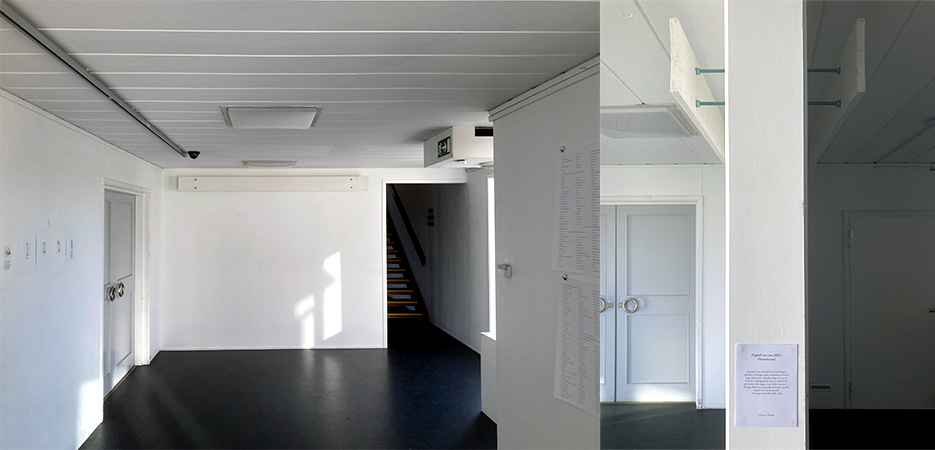
Fåglad (version) (2021-2022)
Galleri Gerlesborg, Bollebygd, dec 2022 - jan 2023
Den tredje installation skedde i Galleri Gerlesborg på Gerlesborgskolan i Bohuslän. Här var förutsättningarna radikalt annorlunda och den träkonstruktion jag tidigare använt mig av skulle inte få plats. Lösningen blev att arbeta om verket och använda en befintlig vägg i byggnaden för att kunna “klyva” svartmes-ljudet.
En maximalt subtil lösning som bygger på två vitmålade plankor som monteras högt upp på väggen på rummets kortsida. För att varsebli “klyvningen” så får man röra sig genom dörröppningen till ena eller andra sidan väggen. Ljudet Korparna fick inte plats i denna version utan Svartmesen fick ackompanjeras av två grafiska verk som löper längs varje långsida av rummet istället.

Storm state / Butterfly Close-up (2018)
Levels of Silence I - Storm State, Vita Kuben, Norrlandsoperan, Umeå, 2018.
STORM STATE (Transitions from black to white. Lower field: sequential order.
Upper field: random order.) (video)
The video Storm State consists of a number of transitions from black to white, in the lower field the transitions fade from black to white gradually, in the upper field on the other hand, the transitions fade in random order. An abstract horizontal line, an intense flickering.
BUTTERFLY CLOSE-UP (sound)
”When working with the video, Norda also began to work with a sound that would work in a similar way, transitions between inaudbile to inaudible. During the work he suddenly found the sound recording of the butterfly. The sound that the butterfly makes with its frenetic but delicate wings may illustrate this idea.”

The Centre of Silence (Exhibition Version 2016 NMG: Rerecorded for New Media Gallery) (2016)
OTIC - Systems of Sound. Group show, New Media Gallery, New Westminster, Vancouver, Canada
What is the nature of sound? What governs its structures, behaviors and boundaries? How do we construct, perceive and understand sound? Four artists explore an epistemology of sound: what we think we know. The works invite us to contemplate how the enigmatic qualities of sound unfold through space and time, and between objects and bodies.
Participating artist: Carsten Nicolai, Tristan Perich, Adam Basanta and Jesper Norda. Curated by Sarah Joyce and Gordon Duggan.

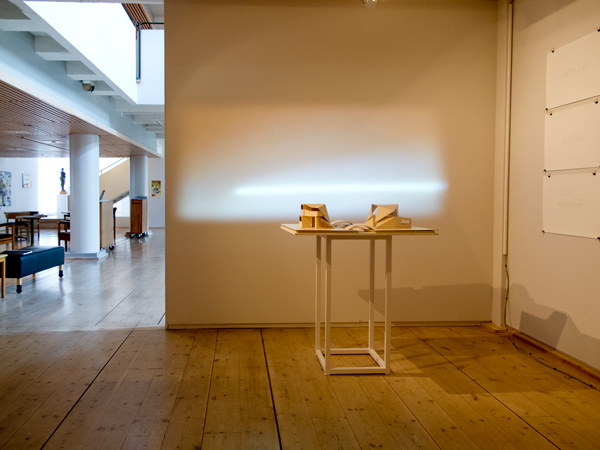
Horisont (2015)
(sound and video on sculpture by Elli Hemberg)
Text by curator Petra Johansson:
Horisont är ett ljusspel, helt abstrakt, men också en sorts arkitekturkonsekvens. Ljus som silar in från en glipa i rullgardinen en tidig morgon i augusti, filmat med iphone, ett snabbt fångat händelseförlopp. Med ljudet höjs abstraktionsnivån. Alla klanger är uppbyggda av en grundton och ett antal övertoner, förhållandet dem emellan följer givna lagar. Motsvarande lagar hittade Elli Hemberg i Jay Hembidges dynamiska symmetri. I verket horisont låter Jesper Norda ett sökarljus svepa över klangernas byggstenar och de blir synliga var och en. Tillsammans bildar de en modell eller en struktur. Ljudet baseras på första satsen i C-dur ur J.S. Bachs Wohltemperierte klavier. Elli Hemberg återkom genom livet till just Bachs kompositioner.
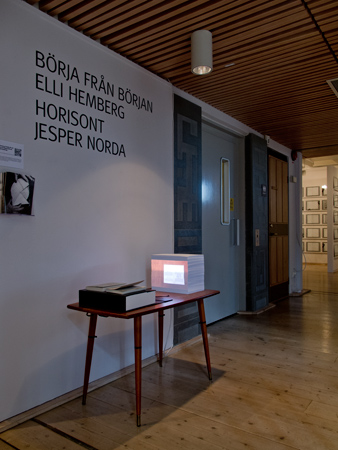
Sol och Skugga (2015)
(video/installation)
Skövde konstmuseum 22/5-15/8: Börja från början, Elli Hemberg / Horisont, Jesper Norda. Curated by Petra Johansson.
HORISONT and SOL OCH SKUGGA are commissioned by Skövde Art Museum and part of their collection since fall 2015.
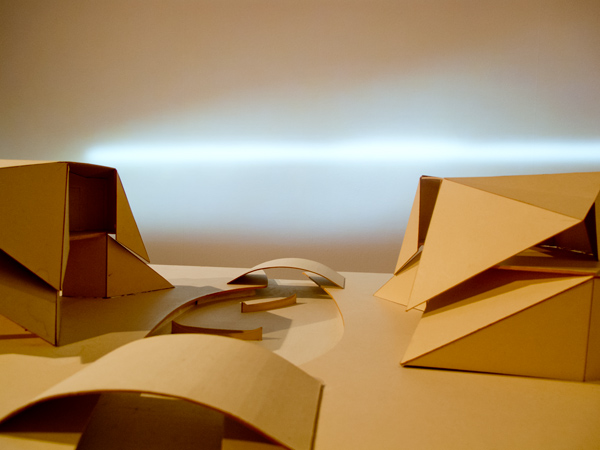

Ur Kinderszenen (No.13) av Robert Schumann (2014)
Galleri Konstepidemin, Göteborg
Sound and video installation: two channel video with two channel stereo sound, sheet of glass with surface transducers, loudspeakers. Images: collage/ink on transparent paper mounted on vintage music paper.
This installation is based on a short piece of music by Robert Schumann. When entering the main room you see a large sheet of glass hanging from the ceiling, trough the glass you see a video projection - the moving hands of the pianist. The music played by the pianist emanates from the hanging glass, a pair of small speakers (surface transducers) are attached to the glass and transforms the entire sheet to a speaker membrane. When entering the inner room another projection is visible - a synchronized view of the body of the piano. In this room the sound of the piano mechanics is heard. An audible split between the music and the body needed to present it - body and soul.
Download complete exhibition folder (pdf, swedish only) // Review Göteborgsposten 2014-03-15
(Still image documentation by Hendrik Zeitler.)
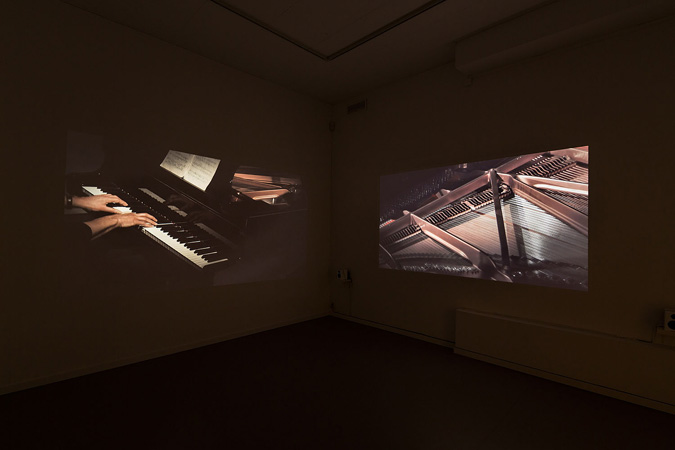
Excerpt from exhibition text by Johanna Willenfelt:
A large sheet of glass is central in the double sense in Jesper Nordas exhibition From Kinderzsenen (No 13) by Robert Schumann at Gallery Konstepidemin in Gothenburg. The sheet hangs from wires in the middle of the room and is the first object the visitor meet when she enters the exhibition. The glass acts as a speaker membrane for the piece of music that gives the show its name. [...]
Through the transparent disc there is a clear view into the next room where the viewer get a glimpse of o video projection. Two films are screened in here, with the projection surfaces placed at right angles to each other. The same course of events are portrayed in both scenes, but from two different perspectives. The first film is a recording of the pianist's hands gesticulating as they hit the keys to Der Dichter Spricht. The second film uncovers the instrument internals, or, in other words, the mechanics of the piano. The two projections are in sync, but the audio that accompanies the films is still not the melody of which "the poet speaks" but what we hear is the sound that the piano gives off before the oscillations from the strings has reached a human ear. [...]
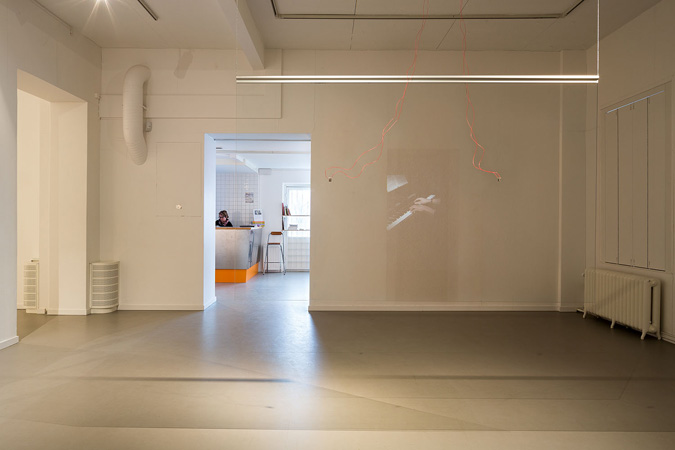
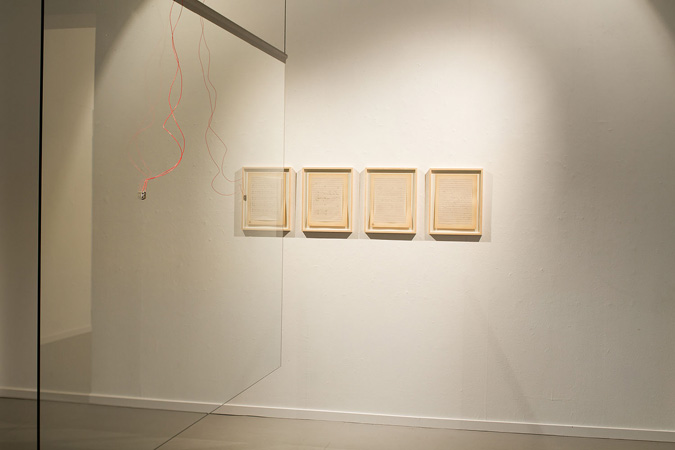
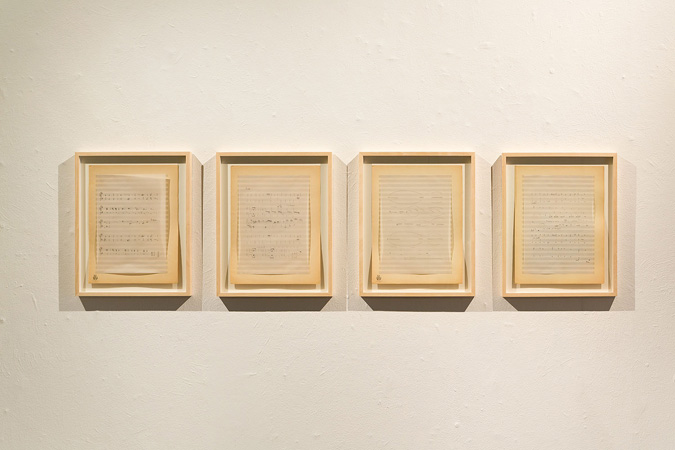

Ground (2013)
4-channel video with sound. Part of groupshow, TWEAKS, Nordiska akvarellmuseet.
Among with four other artists I was invited by the Nordic Watercolour Museum to make a comment on a piece of art belonging to the permanent collection of the museum. I choose to work with a few images by the icelandic artist Georg Gudni.
For the main material of GROUND I created a simulation of mains hum sound using 17 sine-waves. These sine waves were then used to create 4 variations of soundscapes: The flicker, The cycles, The bells, The Waves.
This text was presented next to the videos and the paintings by Gudni:
”In all electrical systems there is a tone. In everyday language we call tone for mains hum. This tone is a result of what we call earthing, or grounding.
It is possible to decompose any sound in a large number of sine waves. A sine wave is the purest form of sound. It is theoretically possible to recreate any sound using sine waves. The thing is to find the right number of frequencies and the right volume ratio between them. The fundamental tone of the sound, and the harmonic overtones that creates the timbre of the sound. The set of harmonics is what separates one sound from another sound. What distinguishes one colour from another colour.
Hz means number of cycles per second. When we talk about sound we use it as a term to measure how quickly the air pressure fluctuates. Thus: the speed at which an eardrum quivers back and forth when it is exposed to a sound.
The frequencies that I have used to model the sound of mains hum is 50 Hz, 150 Hz, 250 Hz, 300 Hz, 350 Hz, 450 Hz, 550 Hz, 600 Hz, 650 Hz, 750 Hz, 850 Hz, 950 Hz, 1050 Hz, 1150 Hz, 1250 Hz, 1450 Hz, 1550 Hz.
Sound waves spread as microscopic tremor in all matter. Everything trembles. Sometimes the tremble hits an eardrum, sets the small fine bones of the cochlea in motion, continues and put cilia in tremble, and later find its way to the auditory centre in the brain: becoming electricity again.”
(Photo credits: Hendrik Zeitler)

Chopin Hours / Still Sun (2013)
Permanent, interactive 4-channel sound installation + 6 c-print silicon mounted on plexi (38X57 cm). Installed in Röselidskolan in Lerum, a school for children aged 6-16 years. The interaction is controlled by a computer with SSD-drive. Measurement microphones is measuring the noise level of the room at all times. Software development by Fredric Bergström in MAX/MSP.
When approaching the piece along the corridor you hear a faint chirping of birds accompanied by soft music. The idea is simple: as long as it’s quiet in the room the birds keep singing. If someone speaks or moves to quickly the birds fall silent. When silence is re-established the birds start to sing again.
The birds singing is accompanied by a soft music, Chopin’s 24 Preludes, Opus 28, played extremely slowly, each prelude having a duration of one hour. A series of images are mounted along one wall: an abstract sunrise at various stages. The images also corresponds with the the black and white keys of a piano - Chopin’s main instrument.
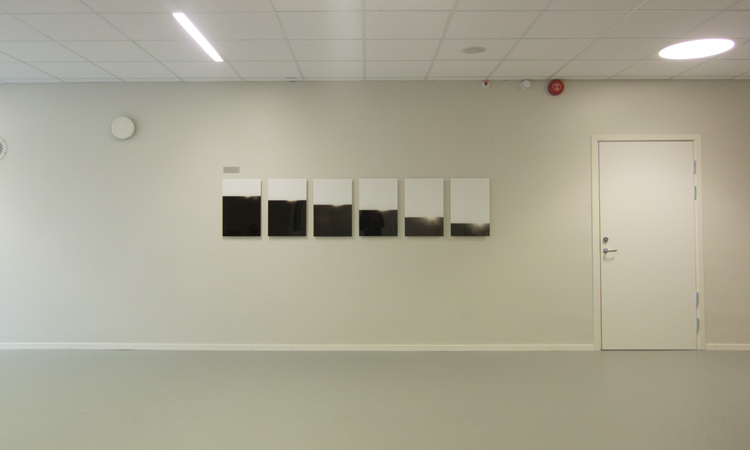

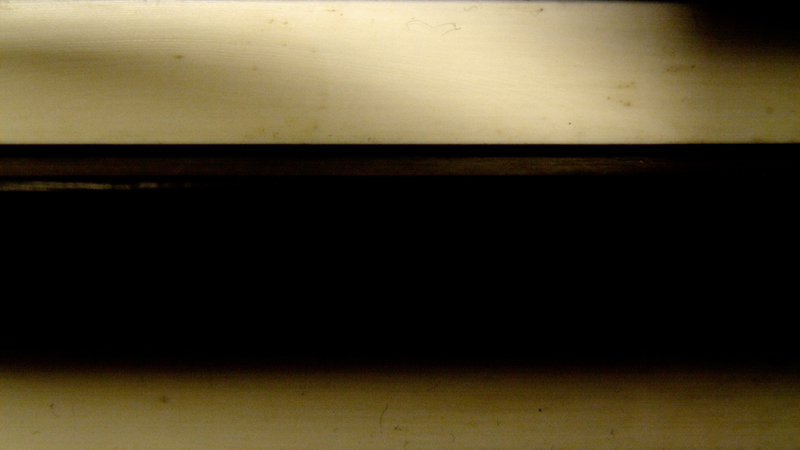
Right Hand – Left Hand (2012)
one channel video with split stereo sound, edition 1+AP
Right hand - Left hand is part of the collection of Göteborgs konstmuseum.
From Göteborg art museum website:
As part of the museum’s ongoing work to activate the collections, the Gothenburg Museum of Art invites contemporary artists to comment on and complement the permanent exhibitions. The first artists to participate are Eliana Ivarsdotter Haddad and Jesper Norda who have chosen places in the museum’s galleries where, in different ways, they interact with the collection. The dialogue creates new contexts and meanings that provide new dimensions both for the exhibited works and for the Gothenburg Museum of Art.
Review Göteborgsposten 2012-11-09
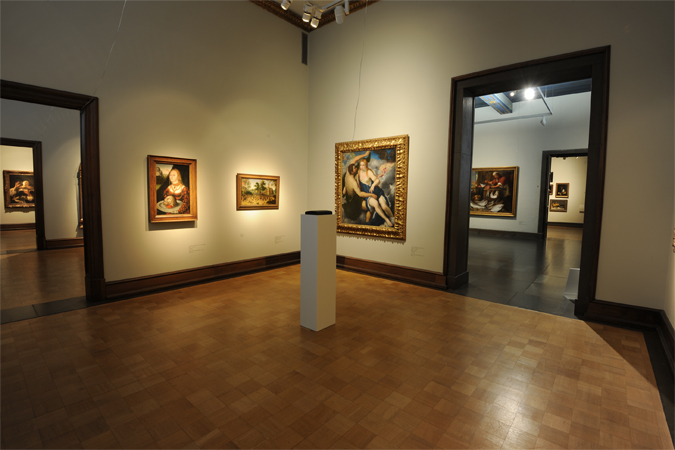
This piece was installed in three adjacent rooms on the 5th floor of the Gothenburg Museum of Art. These rooms mostly contains religious art from 1400-1600. The video was displayed in the center room. The sound in this work is based on JS Bach’s, Nun komm’ der Heiden Heiland, in a piano transcription by F. Busoni.The part of the music that is played by the right hand is heard through a speaker in the right room, the part played by the left hand is heard through a speaker in the left room.
The video consists of an extreme closeup of some piano keys, trembling by the touch of the pianist. When facing the video in the middle room, the sound is “whole”, when you move to one of the other rooms you experience the split of the sound. When standing close to the left speaker, the music played by the left hand rings out on its own, lonely and fragile, the music played by the right hand is heard only very faint, from the distance. And vice versa.
”My first composition professor Ole Lützow-Holm said in an interview, ”the melody is the vibrating thought”. I read this interview right before I would start my education at the college of music... but I can not recall me ever asking him about the meaning of it? In any case, I have carried that sentence with me ever since, sometimes it will come to me when I am not sure of what I am doing, sometimes when I am having a hard time trying to start up a new project. And now it comes to me when I am supposed to write something about my work at the 5th floor at Göteborgs konstmuseum.
However, this work is not so much about thought, it is mostly just body. And the visitor’s presence that binds something together that has been torn apart.” / J.N.
(Photo: Göteborgs konstmuseum)
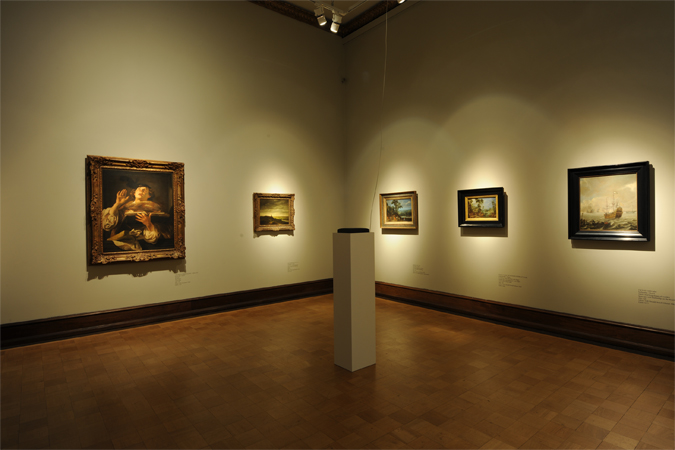

The Goldberg Variation / 13 Hour Sunrise (2012)
Sound (12 hours 25 minutes) / HD-video (12 hours 48 minutes), Konstfrämjandet Örebro, 2012
The Goldberg Variation is based on JS Bach's works Goldberg Variations. Each note / impact is played every two seconds. The dynamics are equalized, all drama and musical direction is removed. The original work is about 30 minutes, this version is 12 hours and 25 minutes.
13 hour sunrise: a black surface where a line of 33 pixels turn white every two seconds. From left to right, top to bottom.
A horizon and a room that very slowly gets brighter.
"The new works by Jesper Norda currently presented at Konstfrämjandet Örebro revolves around the concept of time, or rather the interstices, those that we constantly experience but never think about. Using methods as printed pages with all the seconds of a day and night, where the blackness of the ink varies according to the solar power, we are made aware of these gaps. By converting one medium to another we get insight into the invisible but essential components that create the space that we exist in, and in particular the perceptual process that we experience it with.
Abstract substances often form the backbone of Jesper's work, such as the frequency of a sound wave and how it affects us, but especially the time it takes for a sound wave to travel, the vibrations it creates or the traces after a sound has subsided. The silence is as important as the sound. The illusion only illustrates reality.
With a parallel career as a sound producer and composer with three solo albums behind him, Jesper's sensitivity to the rhythm and the silence in between is a detailed game of pulling apart and putting together. A calculated order re-organizes experiences to clockworks, where mechanically depicted words create mental images, or where every note becomes deserted and left to echo out alone, accompanied by a sunrise that lasts for 13 hours. Reduced to abstraction and the colors black and white, the room lights up, slowly and patiently, pixel by pixel. Time is eminently physical, and no moment is ever the same.
Everything changes, all the time, with the tremendous power of a progressive movement."
/ Sofia Mavroudis, www.curareart.com

Tystnadens Mittpunkt (2010)
sound installation, Kalmar Konstmuseum, 2010
Swedish text with english subtitles. Voice: Henrik Holmberg. (For english voice, go to: vimeo.com/15578905)
Curated by Bengt Olof Johansson.
This piece is a monolog in three parts, each part followed by a sound: silence, sine wave, white noise. A man i speaking about the room, its measurements and the weight of the air in the room. He speaks about the air pressure in the room, the air pressure in the cranium of the visitor of the room - and the fragile balance between those spaces: the state we call silence.
"What about doing nothing? Just be where you are, in your room, with the thoughts coming and going. It’s kind of what we do, all the time, isn’t it? Like right now, when you are reading this text?
There are obvious links between Jesper Norda’s sound installation The Centre of Silence, created for an exhibition at Kalmar Art Museum 2009, and Alvin Lucier’s 1969-classic I’m Sitting in a Room. The two text pieces both use the factual information about the room where the works are performed as starting point for a series of minimal variations. But where the room’s ambience in Alvin Lucier’s case give the sounds an increasingly thick and complex texture, it becomes a conceptual ambience in Jesper Norda’s radical transformation of the material conditions. It stays the same, but it never feels the same. The effect is somehow the complete opposite to Alvin Lucier’s work. By thinning out it becomes complex.
You are there, at the centre of the piece, with a voice reading a formal text telling about the geometrical dimensions of the room and how the ears will react to changes in sound and resonance. But the neutral voice and the dry character of the text will slowly create a tension in the thinking about the piece, a sense of drama. A multitude of rooms will open up. The mysterious effect of the sober aesthetic and the reduced set of expressions is a peculiar and even melodic romanticism. You listen carefully and suddenly you hear the most wonderful harmonies. Where do they come from?
This paradox of using seemingly boring and non-agitated text materials to bring about a personal presence, characterize several of Jesper Norda’s works, for example two of his latest installation pieces, both from 2009: Resist With All Your Heart and Microgram of Light. In the first work a short text is repeated many, many times – ”Stay in a place infected with truth and resist with all your heart” – but for every repetition the word truth is replaced with another word. In the second one a light projector is directed to a big print consisting of an extremely long series of zeros, 17 521 zeros after one another, ending with the figures and letters ”123 microgram of light”.
Jesper Norda started as a composer, but changed direction while he was studying in the composition class at the Music Academy in Gothenburg in the end of the 90s and switched to the Art Academy in the same town for his master degree. A main thread in his artistry since then has been a constant questioning of the borderlines between sound and silence. The visual and the sounding materials are juxtaposed in conceptually challenging ways. Even if his works look and sound quite differently from theirs, he is probably the Swedish sound artist that is closest to the conceptual tradition of artists like La Monte Young, John Baldessari and Sol LeWitt and the reductionism of musicians like Toshimaru Nakamura, Sachiko M and Taku Sugimoto.
Several of Jesper Norda’s works play with the concept of silence. For example the sound installation Tear Gravity from 2005, where two loudspeaker membranes were put on the floor of a gallery, vibrating slowly like heart or a lung, but the frequence making them move – 0,3 Hz – much lower than the human ear can hear (the average human can hear sounds between 20 Hz and 16,000 Hz). Or Field of Love (Hommage à Dimitrios K) from 2007 where an extremely strong bass loop was played on a big PA-system buried 2 feet under the ground; the best position to hear any of the bass tones was to lie down on the grass and listen with an ear to the ground. This literally subconscious underground music materialized as vibrations in the body and in the field where it was played.
When asked about what kind of quality he looks for in a piece, Jesper Norda anwers: exactitude. He wants his works to be as singular and clear as possible, and so pedagogically plain that they border on the abstract and incomprehensible.
This is the enigma of sound art. The attention to what is going, both in the presence and in the absence of sounds, brings the work right to the centre of silence. And one of the best ways to achieve this is to do nothing."
/ Magnus Haglund
Catalogue (swedish/english). Texts by Marie Norin and Magnus Haglund.
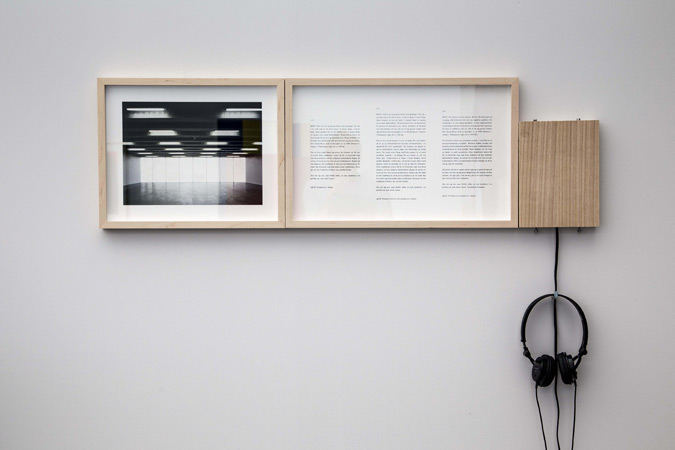
(documentation edition 1+AP)
Kalmar konstmuseum, Drömmen om Samlingen, 4/7 2015 - 30/8 2016.
The Centre of Silence is since july 2015 part of the collection of Kalmar Konstmuseum.
read more (swedish)

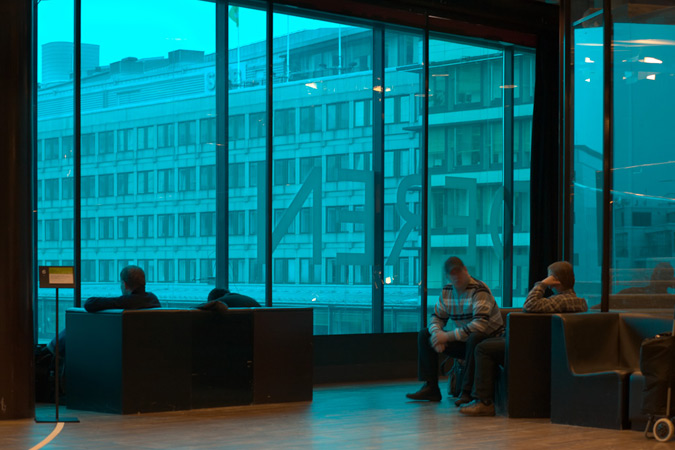
Shelter (2010)
Ta Plats! Stockholms kulturhus (2010)
2 CD-players, speakers attached to window, dark blue-green film covering the window.
Sound of wind and metal breaking down resonate in the window screens.
read more (swedish)


The Pumps / The Paths (2005)
Tear Gravity, Galleri Mors Mössa 2005
The speakers (title: The Pumps) are moving slowly up and down, as a lung
or a heart.
The speakers are dead silent,no sound is heard.
The movement is created with strong direct current,
the cables (title: The Paths) were placed so they reflect in the floor,
the floor became a waterlike surface.
The Pumps is released on CD by Kning Disk.
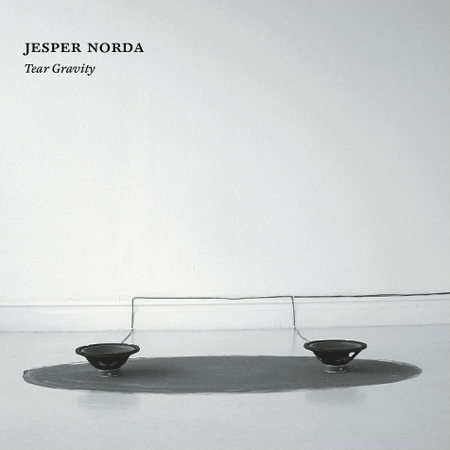

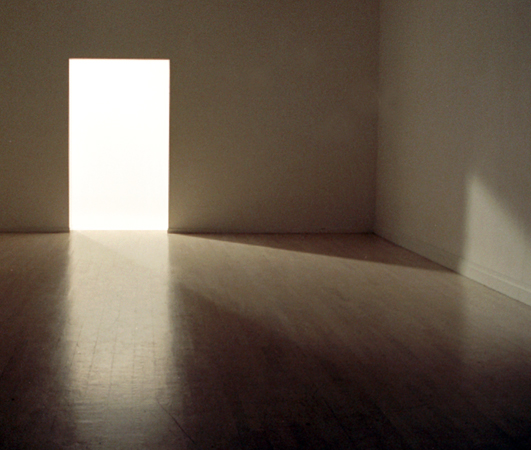
50 Years in a Space of Nine Days (2002)
sound installation, BREAKDOWN, Galleri Rotor, Göteborg 2002
Text in the exhibition space:
"We experience sound with extremly low frequency as a rythm, not as a tone. The human ear begin to hear tones at 16 cycles/second.
It´s easy to imagine the sound of a clock. It´s ticking. I can imagine the ticking as a sound that follows you all the time. Not as a ticking sound per se, but as a long, long expanding sound with a frequence of 1 cycles/second.
(In my case, the length of this sound is about thirty years by now.)
A sound with a length of 50 years and a frequence of 1 cycle/second, gets a frequency of 2213,63 if you squeese it in a space of nine night and days."
A loudspeaker was connected to a sinus-wave generator and placed in a room, a light projector was directed towards the entrance and the entrance was sealed with a transparent fabric. The sine-wave generator was set to 2213.36 hz and was turned on at 12.00 pm 021006. It was turned off at 4.00 pm 021014.
A sealed room in wich a long/short period of time were exposed.
This piece have also been exhibited in MAF 2003, Chiang Mai, Thailand

installations .
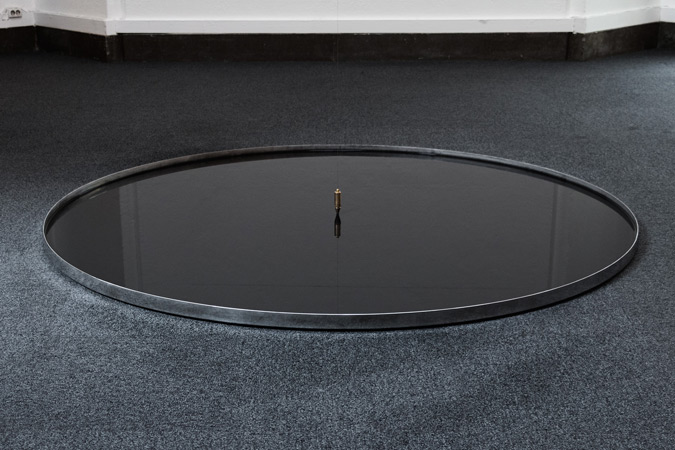
90° (2016)
(pool, ink, line, plummet. 2X9 meters)
Förjaga bristen på sammanhag, Göteborgs konsthall, 2016.
Participating artists: Nanna Debois Buhl, Sara Lännerström, Jesper Norda, Lisa Torell, Anna Ling, Laura Oldfield Ford. Curated by MIkael Nanfeldt.
From review, ARTFORUM:
A plumb line suspended from the ceiling, brushing the surface of a black pool of ink, 90º, 2016, and a faint pencil line across the wall, like the projection of a blueprint, 1° (below this line is half of the universe. Above this line is half of the universe), 2016, have the appearance of coherence and stability. But the line trembles, the ink splashes, and the horizontal line inclines almost imperceptibly. These pieces, by the Swedish artist Jesper Norda, open “Banish the Incoherence,” an exhibition of six artists whose work relates to urban space and inhabitance.
From exhibition catalogue:
From the ceiling rose in the centre of the octagonal room, a plummet hangs from a line. As the plummet brushes the pool's pitch black surface a tension arises at the intersection of the vertical and the horizontal. The water is drawn towards the plummet and raises the level of the liquid surrounding the metal. Jesper Norda's work can be said to function as a kind of spirit level with the title 90° indicating the desired angle. The line growing out of the pool's shiny surface must be completely still in order to achieve this angle. Is it?
Shown here for the first time, Norda's work reveals the often invisible physical laws that surround us and control our world. The field of tension between the surface and the pendulum creates a pull, an attraction between the two parts. The fluid and the pendulum are related to each other, affecting the world around them just as they are affected by it."
(photo by Göteborgs konsthall)
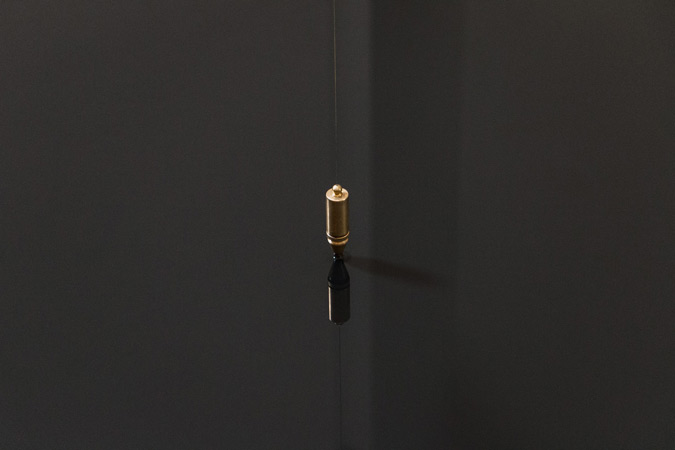
Detail.
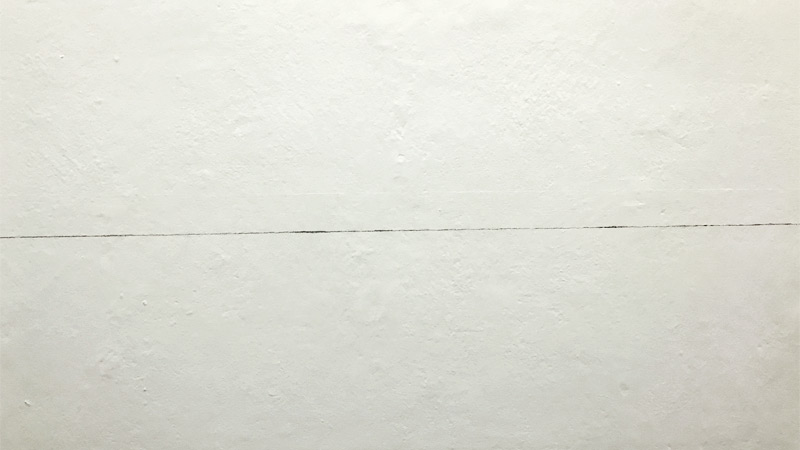
1° (Below this line is half of the universe. Above this line is half of the universe) (2016)
Pencil on wall.
From exhibition catalogue:
"The pencil line we see on the white wall in the Octagon is also created by Jesper Norda. For this minimal spatial intervention, Norda has started out from the horizon line, which we use to orient ourselves in everyday life, a line that keeps us in balance. As the titles suggests, the line on the wall is not entirely horizontal, instead it have an almost negligible inclination of one degree. Perhaps one can imagine that the pencil line intersects the galleries and together with the vertical line in Norda's work 90° constitutes a system of coordinates that is in a state of constant flux and reassessment."

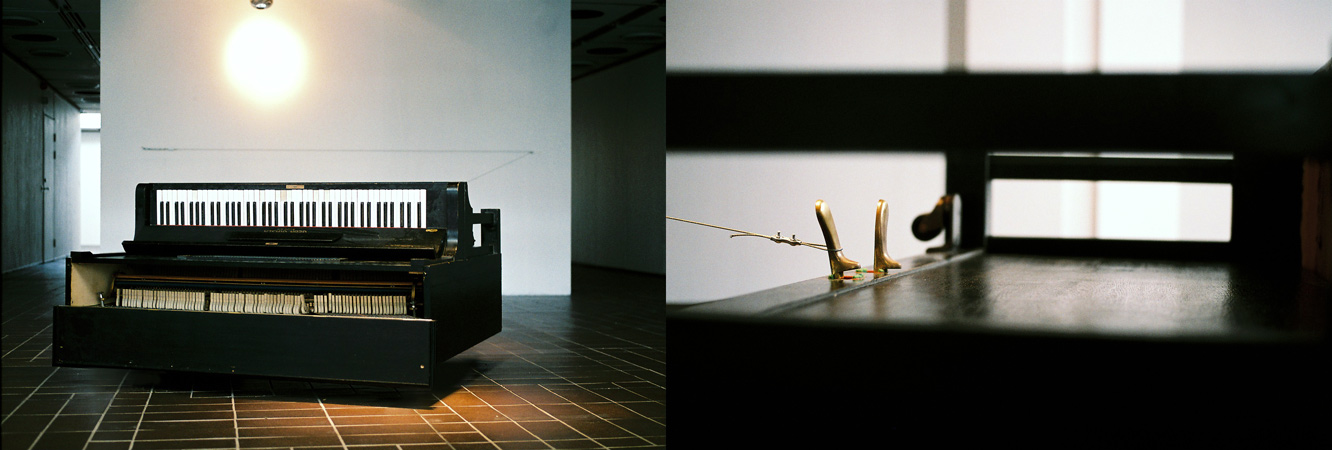
Horizon Release (2009)
Piano, wire, lightprojector. Sandvikens konsthall 2009.
A piano laid down on the floor, with a wire attached to sustain
pedal. The wire was connected to a wall with two hooks, making a
tense line on the wall continuing down to the piano.
A lightprojector was directed to the wall.


Reader (2009)
Videoprojection (loop). Sandvikens konsthall 2009.
An illusion of light falling in from a window,
it flickers faint but intense (like if it was a storm outside).
A red dot moves quickly and random along the pattern of the floor.

video.
Stone Clock (alternative title: 1000 Stones/1000 Titles: #702 substance (cut out)) (2019)
The sound material consists of 1000 stones falling, one by one, against a rock face. I made the work as a kind of solo performance one evening in spring 2019. I picked up a stone and then let it fall. Then I repeated this movement 999 more times.
These two edited versions represent two different time sequences: like two clockworks talking about different things.
Landslide (alternative title: 1000 Stones/1000 Titles: #329 grey fire) (2019)
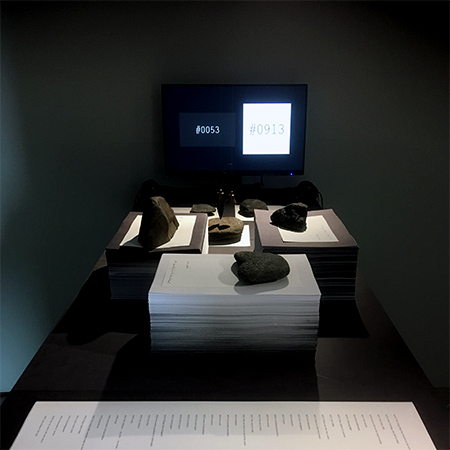
Installation view: Crossworlds,
Tredje Våningen, GIBCA Extended 2019.

Gun Clock (revolve) (2018)
Sound: A recording of a mantle movement on a Beretta 92.9mm.
The recording is cut up and laid out in an even rhythm, one sound fragment/second.

Inverted Night / Bach Engine (2017)
Sound, video. Comission by Konst i Blekinge.
Inverted Night/Bach Engine är ett 42 minuter långt ljud- och videoverk. Ljudet baseras på J.S. Bachs Goldbergvariationer.
Goldbergvariationerna består av en aria samt 30 variationer på denna aria. I detta verk låter jag dem spelas samtidigt, som om tonerna vore utlagda i ett rutmönster, eller kanske som kugghjul som hakar i varandra. Samtidigt får lyssnaren pendla mellan två olika skikt: ett yttre skikt där pianoklangen är igenkännbar, samt ett inre skikt: den klang som samtidigt alstras i instrumentets kropp. Videon består av bilder på natthimlen i inverterad/negativ form. Dessa bilder fungerar som ett grafiskt partitur för stycket. Ett försök att spänna en båge mellan ett oändligt universum och ett par envisa fingrar som frenetiskt hamrar mot en och samma punkt.
Bach Engine (Remix #1: Dark Matter) (2017)
Sound, video. Comission by Konst i Blekinge.
Bach Engine (Remix #1: Dark Matter) är en remix av Inverted Night/Bach Engine. Varje musikaliskt ljud består av en grundton och ett antal övertoner. Hur dessa övertoner står i förhållande till varandra avgör ljudets klangfärg. I Remix #1: Dark Matter har jag byggt en struktur av de första 40 övertonerna baserat på Goldbergvariationernas grundton. Denna struktur ligger som ett inverterat filter på originalverket: allt som inte tidigare klingade klingar nu, allt som tidigare klingade har tystnat.

Torch / 1 Minute (2013)
HD-video, no sound, 1 minute/loop. TORCH / OTHER PRECIPITATES, Galleri Svilova, Göteborg.
The video starts with a flash of light – followed by a counter measuring how far the light will travel trough space during the following minute.
“Since light waves use all of their motion to travel through space at Light Speed, they have absolutely no motion through Time. Every photon that has ever been produced exists in an ageless state. (To us, the light seems to move through time but to the photon, time is standing still.) The universe ages, light does not.”
- BACKWASH -
The first thing that happens is a sense of backwash. There is no pressure drop, but it feels like that’s exactly what has happened. And then I fall. Into absolute stillness, absolute silence. Imagine that you are the light of the torch that for a second flares up and then falls 17987162521 meters down into space. Imagine in the same way that you are each and everyone of the letters that, for example, make up Samuel Becketts complete book of poems Echos Bones and Other Precipitates, that you are the words disassembled, a print raster, all the speech in the world, cry, wonder, despair, desire, rage transformed into photons and that you are now, falling through your own skull, encased in the world and at the same time the world encased in you, as the poem says: ”through the sky/of my skull shell of sky and earth”, imagine yourself consisting of light and words, the only things in the universe that last and are completely still in the collapse, falling straight out into darkness and time. Imagine that stillness. Then imagine the core of precipitation, the crack before precipitation, the placenta when the fetus lets go and falls, the cycles and inversions of the electrons in the human brain, the blood vessels in the eye, x-rays, hastily sketched faces, rivers, traffic networks, borderlines, rifts, cracks, the remnants of motion.
Each time I stand before a work of art made by Jesper Norda giant rooms of silence open inside me. Rooms I know I have to remain in. To be able to remain human. Frightening? Beautiful? Filled with sadness? Indifferent? Shadow and light on a white paper. The words still ”unworded”, yet complete, unachievable. A human being being human: with the torch ”mark ones presence in the darkness, send messages to someone, warn someone, call for help". / Marie Norin, 2013.

Animation: Silent Structures (digital edition: frame 1000-1599) (2013)
1920X1080, length 30 min. Edition 1/1.

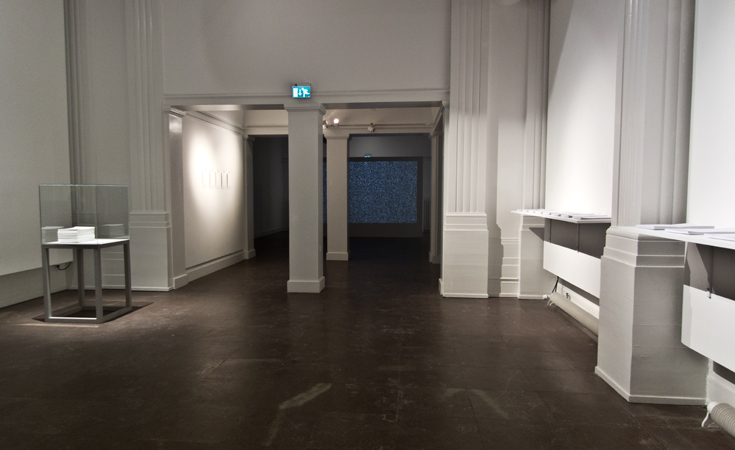
Explosion Clock (2013)
Karlskrona Konsthall 2013. Installation view.
Explosion Clock (2013)
HD video, no sound, length 16 min.
A black surface is turning white, pixel by pixel. And then black again.
A visual indicator of time: a clock.
Video above is a simulation.

Magnolia CLock (2004/2012)
HD-video, no sound (11 hours 17 minutes), Konstfrämjandet Örebro, 2012.
Magnolia clock consists of all the words in the script for the film Magnolia by PT Anderson.
All words; camera directions, directors notes, dialogue, location descriptions, camera angels etc etc.
No capital letters, no punctuations, the words just line up one by one, second by second.
A visual indicator of time: a clock.
Video above a short excerpt, the original film is 11 hours, 41 minutes and 17 seconds.
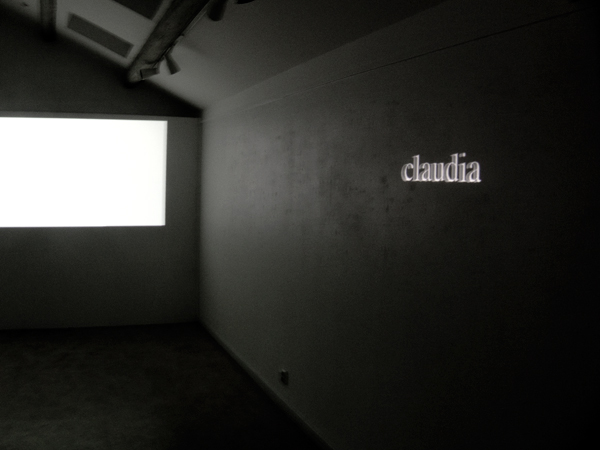

Verge (2009)
Videoprojection (infinite loop).
An infinite zoom out, you feel like you are leaving the ground but you remain in the same position.
The subtitle flickers a bit: Little by litte, everyting will come to normal.

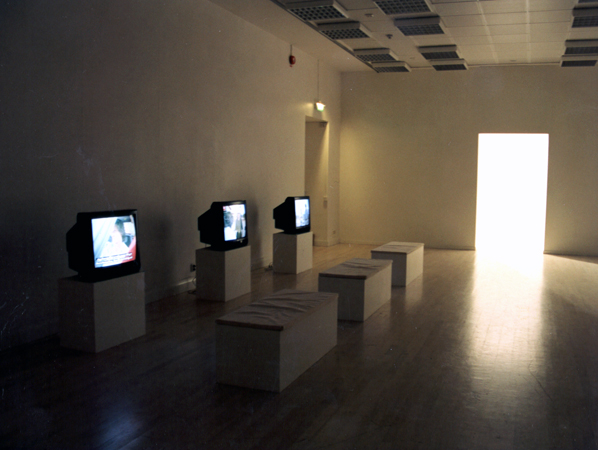
9 Attempts to Break the Chain of Events (2002)
3-channel video, BREAKDOWN, Galleri Rotor, Göteborg 2002
_______________________________________________________________
Performance version (2000):
Rent the movie Breakdown (dir: Mostow, 1997. Cast: Kurt Russel and Cathleen Quinlan mm).
In the slow and quiet part when Amy has left Jeff by the road, imagine a voice-over reading one of the nine texts. Stop the film exactly before Jeff enters Belle´s Diner, rewind and return it. Or make the procedure all over again with a text you haven´t used.
_______________________________________________________________
In BREAKDOWN this idea was realised, nine clips on three monitors.
9 ATTEMPTS TO BREAK THE CHAIN OF EVENTS is dedicated to my father.
Wiew online version.

graphic.
prints .
paper .
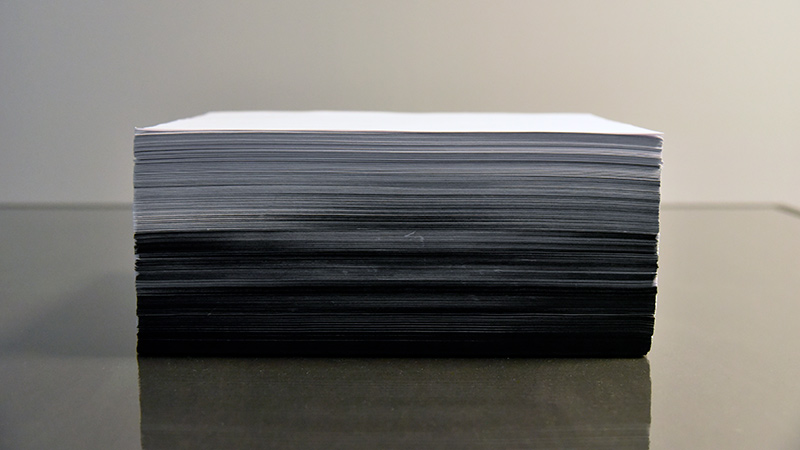
1000 Sheets (2018)
1000 Sheets consist of 500 black A4 sheets and 500 white. The sheets have been sorted: a gradual transition from black to white. A pile of paper that acted as a link between the works in the exhibition Storm State (Vita Kuben, 2018): the butterfly’s dry fluttering, the flickering ashy frames of the video, the text fragments in 1000 Titles.
(photo by Helena Wikström)

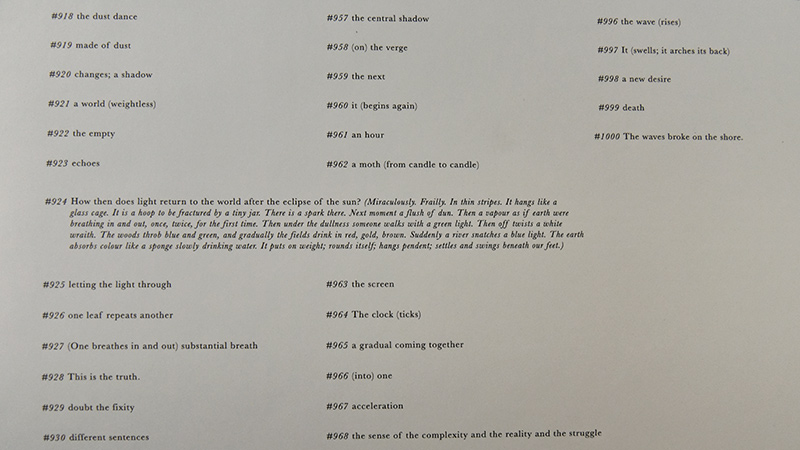
1000 Titles (The Waves by Virgina Woolf) (2018)
1000 Titles consist of thousands of fragments from Virginia Woolf’s novel the Waves. While reading the book, all words that could be used as a title were underlined. The content of the book fell apart and reassembled, like sunlight playing over a façade, sometimes separating the details, sometimes binds it together.
(photo by Helena Wikström)


Silent Structures (frames #1600-1647) (2017)
Stills ur animation (oändligt tidsförlopp). Digital print på ritfilm, monterat mellan två UV-glas.
Exhibition: Polyfoni 4, Galleri Thomas Wallner, Simris.
Collection: Region Skåne (#1600-1635), private (#1636-1647)
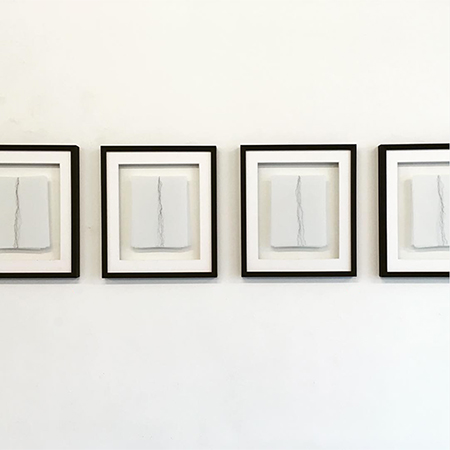

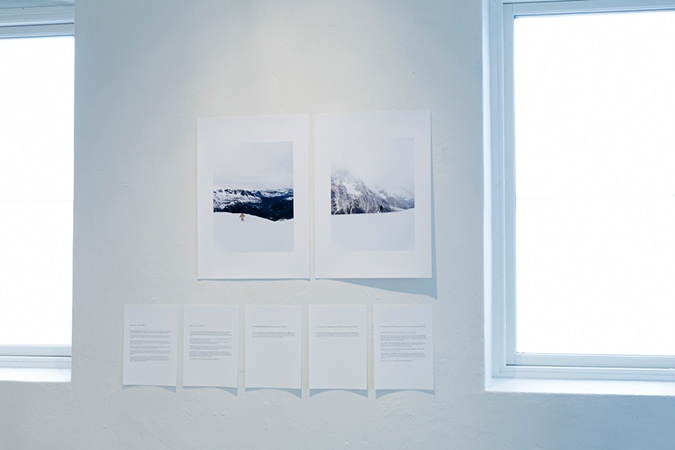
E+M leaving me on top of a mountain (2017)
Digital print, various sizes. Revision, Tredje våningen, Göteborg, 2017. (Photo by Attila Urban.)
I utställningen Revision undersöks de gränser som samhälleliga ekonomiska regler skapar. Istället för att konsten skall anpassas och reduceras till näring önskar vi att den politiska diskursen ändrar riktning och återtar konstens grundmening, att vara filosofisk, söka svar på mänskliga villkor, och belysa nödvändigheten att öppna och vidga konstbegreppen istället för tvärtom. Vi vill i utställningen göra en revision av konstbegreppet i stort och smått. Efterforska och öppna upp för tolkningar och omformuleringar som kan komma att användas som metod för framtida projekt och konstnärer. Med utgångspunkt i ämnet revision kommer vi i utställningen behandla problematiken om hur konstnärligt arbete hanteras, värderas, används och utnyttjas.
Utställningen innehåller verk av en rad nationellt och internationellt välkända konstnärer och spänner över en stor bredd av samtida konstnärliga uttryck.
Medverkande konstnärer:
Lotta Antonsson
Patrik Bengtsson
Trinidad Carrillo
Loulou Cherinet
Klas Eriksson
Carolina Falkholt
Juan-Pedro Fabra Guamberena
Oscar Guermouche
Annika von Hausswolff
Goran Hassanpour
Henrik Håkansson
Anna Lamberg
Dorota Lukianska
Maria Magnusson
Pia Mauno
Bo Melin
Jesper Norda
Mattias Norström
Ylva Ogland
Linda Tedsdotter
Johan Zetterquist

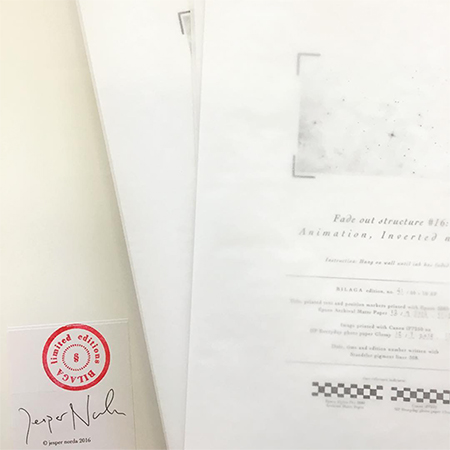
Fade out structures #16: Animation, Inverted night (2016)
Digital print. Bilaga Limited Editions (50+10 AP).
"A subtle animation of fading stars, Jesper Nordas work for Bilaga gives every subscriber a fading image of an infinite sky."
"Animation, inverted night består av en bild, som i sin tur är monterad på ett ark med en instruktion. På detta ark är en beskrivning av när bild respektive instruktion är utskriven. Iden är enkel: bilden kommer att påverkas av tid snabbare än det papper som instruktionen är utskriven på. Bildmaterialet är hämtat från NASA:s bildbank innehållande bilder av stjärnkonstellationer. Jag arbetar ofta med digitala media, jag har gjort några animationer med extremt långsamma förlopp som visats genom mediaspelare och projektion (exempel: 13 hour sunrise (Örebro, 2012), Explosion clock (Karlskrona konsthall, 2013). Animation, inverted night är en animation som är så långsam att normal uppspelningsmedia är överflödig."

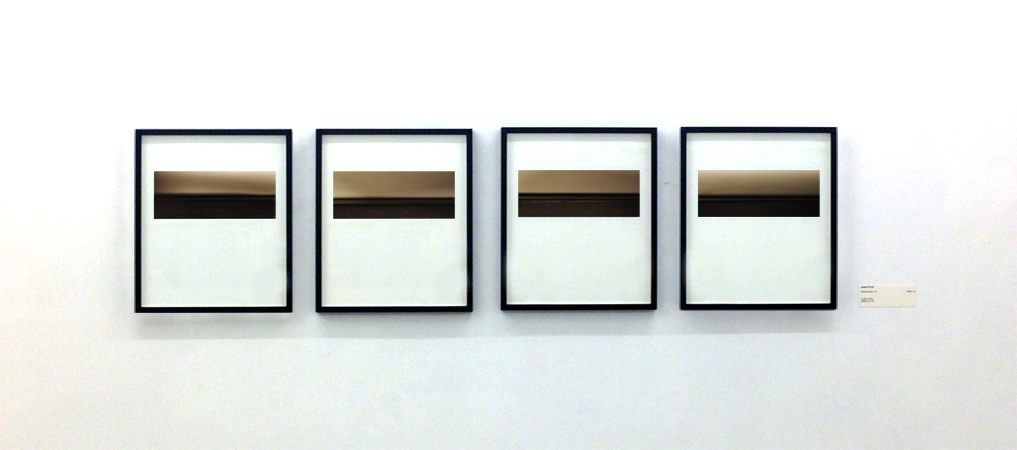
Horizon Keys (2015)
C-print, 33X22 cm, edition 5+AP. Polyfoni 3, Galleri Thomas Wallner.
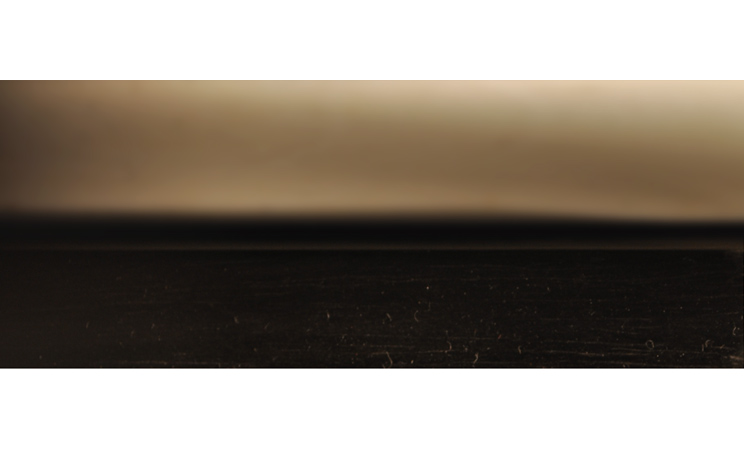
Detail.

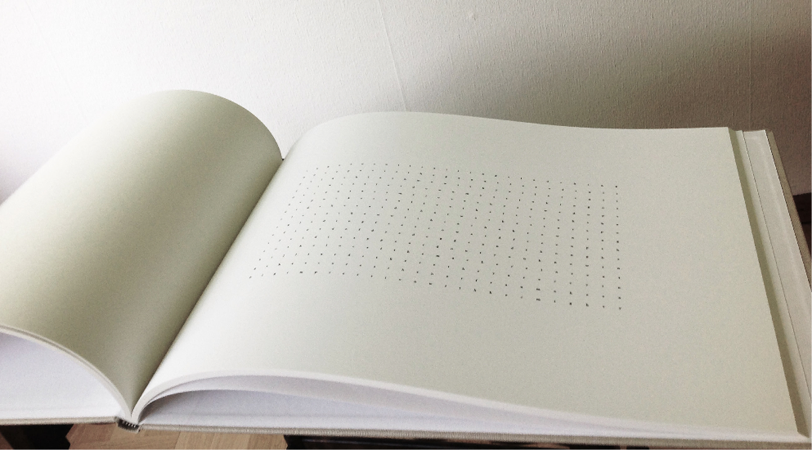
Echos Bones and Other Precipitates (2013)
33 prints in handmade book, 420X297 mm, pigment print on archival paper, edition 5+1AP.
All the letters in Samuel Becketts collection of poems: Echos bones (and other precipitates). In original order, spacing between each letter, no capital letter, no punctuation. All chapter and verse indications are removed. The words of Echos bones reduced to sheets of abstract patterns, varying in intensity.

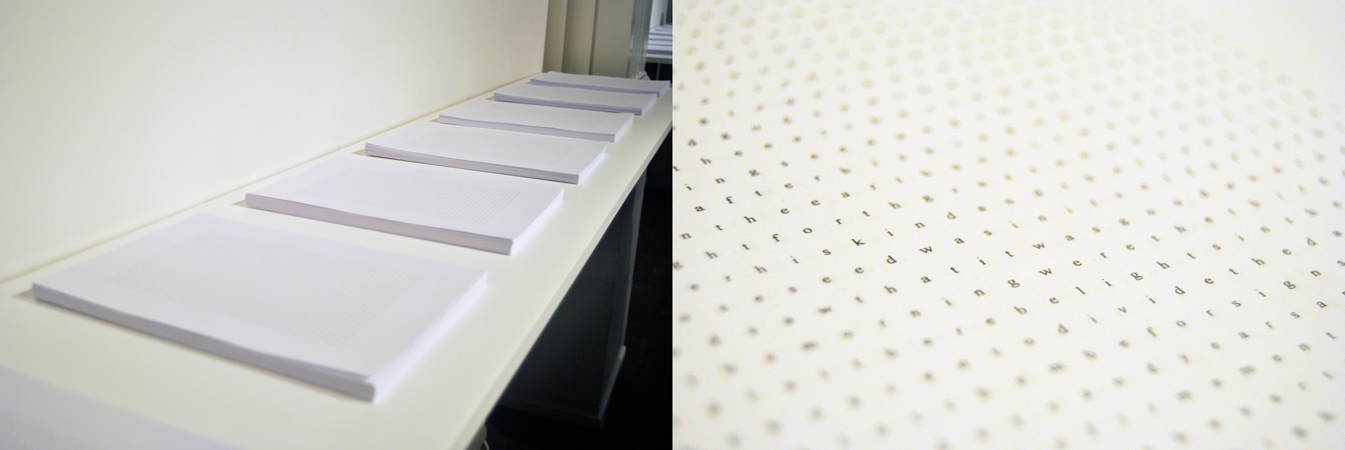
Bokstäverna (2013)
2159 A4-pages. Inkjet print.
All the letters in King James Bible. In original order, spacing between each letter, no capital letter, no punctuation.
All chapter and verse indications are removed. The words of the bible reduced to sheets of abstract patterns, varying in intensity.

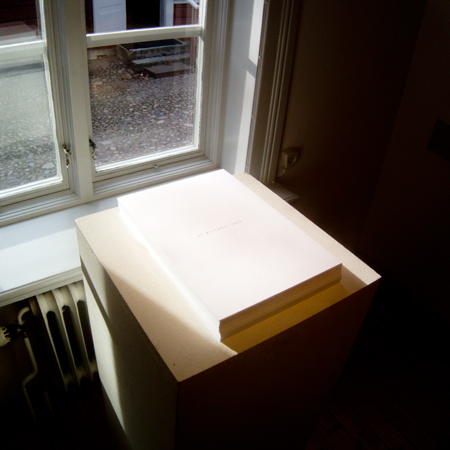
17 December 2011 (2012)
193 A4 pages. Inkjet print, paper: mohawk matte, edition of 5+1 AP.
All the seconds in a day in a time code, presented as a stack of paper on a podium.
The blackness of the ink "follow" the rise and setting of the sun december 17, 2011.

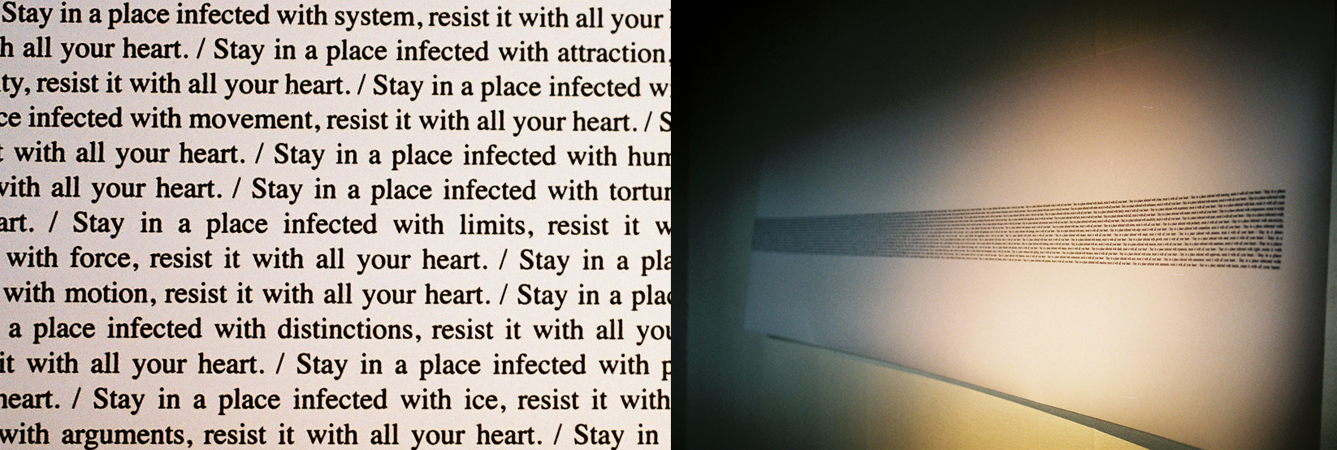
Resist with all your heart (2009)
Print (260 X 53 cm, edition of 5).
The text ”Stay in a place infected with truth, and resist with all your heart”
is repeated many times. For each repetition the word ”truth” is replaced with something else.

outdoors.
Åskhuset (2014)
Skankaloss, Gagnef-festivalen 2014


Field of Love (Hommage á Dimitrios K.) (2007)
CD-player playing a bass loop, large PA-system. Skankaloss, Gagnef-festivalen 2007.
The loop was played extremely loud, if played when earth still open it was impossible to stand near the speakers.
After putting back soil and grass it was reduced to a throbbing, whispering beat - a movement in the ground,
best experienced when laying down on the grass.
